
 |

|
|
|
|
Height:
5' 7½" (1,71 m) Weight: 154 pounds Eyes: blue Hair: brown Marriages: (1) Ella Wilson, actress (Nov 27. 1889 - 1894, divorced) (2) Anna Augusta Chance (May 11. 1896 - Sep 10. 1943, her dead) (3) Loretta McGowan (Jan 10. 1945 - Aug 26. 1950, divorced) |
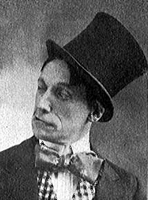 |
|
Above right:
Picture of Charles E. Grapewin uit Above the Limit published in The New York Clipper (Dec 22. 1900). |
|
|
On December 20.
1869, in the small town of Xenia, Ohio, Charley
Ellsworth Grapewin was born to Joseph H. Grapewin and Charity Lorena
Heaton. Expected to follow his father's career
as glassblower or in the lumber business he ran away from home at an age
of 10 to begin a lifetime of upward mobility within some form of show
business. Spend his boyhood in Massillon, where his father owned
the Hotel Massillon, near the Pennsylvania Railroad depot. He would have
finished high school in Wellington, Ohio. At the ripe old age of 14 (ca. 1883), Charley was floor manager of the Princess Rink in Cincinnati. He used his ability as a roller skater to gain entry into (at least two different) circuses. It all started when he won first honors in trick, fancy and acrobatic roller-skating in a Cleveland tournament. This feat brought him an offer from the Forepaugh and Samwell's* Circus where his routine was performed on the first elevated stage to be built under a big-top. |
|
|
At one time in his early
career made balloon ascensions and jumped from a balloon in mid-air in a
parachute, at $5 a jump. A couple of years later (ca. 1886) he got up a stage act, mixing straight acting with acrobatics (high wire and trapeze). He even enlisted as a volunteer in the Spanish-American War in 1898. |
|
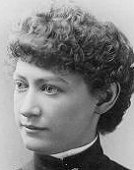 Right: Ella Wilson in 1888. Ella
was a member of Cordray's Stock Co. at Portland, Oregon (1890 - 1891). Right: Ella Wilson in 1888. Ella
was a member of Cordray's Stock Co. at Portland, Oregon (1890 - 1891).
Nov 27, 1889 in Bridgeport, Conn. he married Ella Wilson, daughter of Fred "Pop" Wilson, formerly stage manager of the Casino and Miner's theatres in New York and niece of George Wilson, the minstrel. |
|
|
He would later go on to work for
P.T. Barnum Circus with an aerial act called "The Silbon Troupe".
Travelling all over Europe and America. He considered one of the high points of his career, the time
he teamed with Eddie Silbon and
|
|
|
At one time Charlie “Nix” Grapewin member of the Witmark
company took the role of His Royal Nibs,
Emperor of China. In the variety on the same bill he appeared three
times: with “The Three Clovers” in their artistic acrobatic act entitled‘Excitement In Chinatown’;
in “Spanish Rings” (with Silbon and King) and in “The Silbon Trio,” which
introduced a “Triple Trapeze Act and wonderful backward and forward
swings and hand-to-hand catches, leaps, etc.” A man worked for his
salary in those days! Grapewin had a curious habit of ordering, in every town that the Witmark company played, a sewing machine sent up to his room on approval. As an old circus man, he was accomplished with the needle and self-help. During his stay he would use the machine for repairs to his clown costumes or for the sewing of new ones. Then, when the company was ready to move on, he would call up the machine dealer, inform him that it was not quite what he wanted, and add, “Better send for it today, as I’m leaving town in the morning.” In July 1891 he was billed as "The comedians, King and Grapewin", next to several other circus acts (Silbon Trio, ...) in the auditorium of Cordrays Theatre in Seattle. He moved between the theater and the circus until the end of the decade. He never returned to the (big-top) circus, although he did lend his skills to vaudeville for a time, writing plays along the way and touring with his own productions. |
|
| Grapewin was now hooked on a theatrical career. From there he was hired for his first professional stage work. "I thought I was an actor," he once said of this period, "but the first thing they taught me was how to handle a six-span of mules, the transport of the theater company. Then I was taught how the tent, in which we played, was set up. Then I had to learn how to cook, to prepare the food for the group while also washing the clothes of the players. For one of the performances I had to learn to blow the trumpet, while on another evening I was ordered to handle the trombone because one of the fellow players had had enough of the company and left. And all that was classified under 'acting' ". | |
|
Dr. Cupid was the title of a new farce-comedy by Frank Daniels in February 1893 both C.E. Grapewin and Ella Wilson were a part of the 24 acting members. In July 1893 Charles Grapewin and Ella Wilson have been engaged for A Crash in China. In March 1894 A High Roller, one of the funniest of comedies ever produced on stage opened at the Hoboken Theatre. Charley played the role of the valet Dennis as was heralded as a genuine artist as funny as could be. Co-starring were Charles Boyd and W.J. Tucker. Earlier Grapewin played in "Uncle Dan'l, a Messenger from Jarvis Section," as saloon keeper. Miss Eloise Willard and her co. presented the first-class musical comedy The Little Speculator at the Portland Theatre. Messrs. Grapewin, Haven, Mahar, Young and Jackman, and Misses Carlotta, Crosby, De Shorbe, and Browne were among the company's members. (Sep. 1894) Late 1894 Grapewin divorced his first wife. In August 1894 he was served
whilst working on Dr. Cupid in Catskill, New York. |
|
|
Subsequently
he met and
married
(May 11. 1896), the then 15 year old, Anna Chance,
'The Belle of Wellington, Ohio'. Grapewin was
playing with a company in Trenton, N.J. and Anna was daughter of a
socially prominent family (her father was baseball great Frank Chance). It wasn't possible to obtain her parents'
consent, so the couple eloped. They were married by a justice of peace
somewhere in the neighborhood of Camden, N.J. In 1896 - 1897, he performed in the duo "Grapewin & Evans", with the skit A Baggage Check (Portland) with Lizzie Melrose, Nettie Black, Louis Martinetti, Eckert and Heck. Thomas Evans had by then been his regular stage partner for many years. |
|
|
Grapewin began to
write skits/playlets/stage plays which he sold and acted in and also
Charley and Anna became a permanent stage act. The first was A Jab
of Keely (1897) later renamed
Mr. Spinglehoffer
where Charley's conception of the German who gets
twisted in his thoughts and words was considered excellent. Anna sang a
ballad. Charley and his wife were appearing in the sketch, Above the Limit, at Keith’s Union Square Theatre in New York. Under the direction of Walter McCutcheon, the sketch was filmed on Hackett and Carhart’s roof above the theatre by the Biograph-Mutascope company. It ran for about six or seven minutes on the screen, offering the first screen kiss and other entertainment innovations that others now claim to have introduced. Grapewin really began in silent films at the turn of the century. His very first films were 2 "moving image shorts" made by Frederick S. Armitage; Chimmie Hicks at the Races and Chimmie Hicks and the Rum Omelet (aka Above the Limit**), both shot in September and October of 1900 and distributed by American Mutoscope & Biograph in November of that year, the latter with Anna in it. Grapewin also appeared in a third short film 3 years later, Jimmie Hicks in Automobile, filmed by G.W. Bitzer. For some reason Grapewin failed to find a long-term place in silent films. Reportedly Grapewin also appeared in the original 1903 Broadway theatre production of The Wizard of Oz, as yet this is unconfirmed and very unlikely. He actually had few Broadway theater credits with The Awakening of Mr. Pipp (Haverly's 14th Street Theatre, Mar 21. - May 9. 1904) and with that other musical comedy It's Up To You John Henry (Grand Opera House/West End Theatre, Oct 23 - Dec 23. 1905) |
|
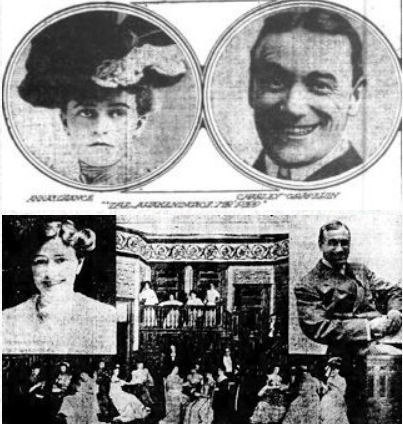
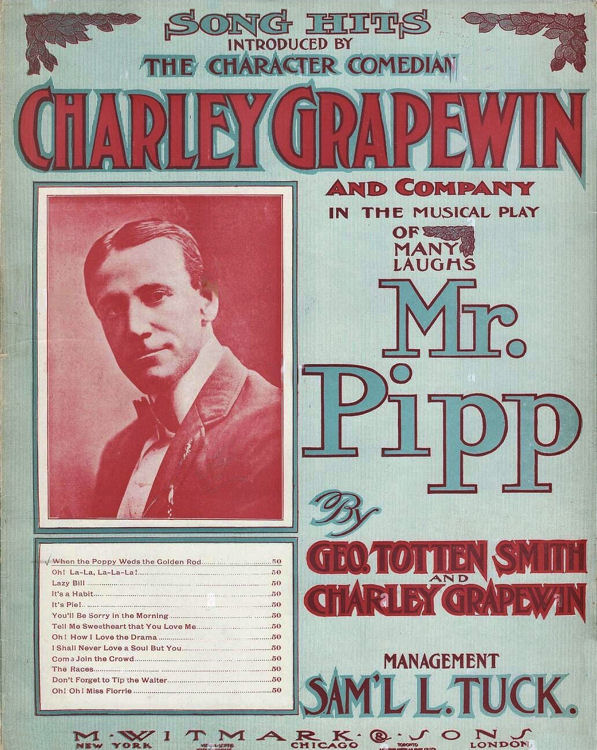 Above: Picture in Newspaper for The Awakening of Mr. Pipp (1903) and a scene from The Awakening of Mr. Pipp, with Charley Grapewin and Anna Chance. (Nov 1907) Below: Musical sheet for the Song Hits from Mr. Pipp with a listing of the songs (1903). |
|
|
Great success came with
The Awakening of Mr. Pipp, with which he toured more than
a dozen years. The musical comedy, which started in 1900 as a one-acter
(first performed in Wilmington, Delaware),
grew after two Seasons into three acts being performed by some
forty artists. Touted to be a play that "will go down into
theatrical history with a record that will have laughter written all
over it in bold letters". He kept adding new and attractive songs,
retaining also the best of the songs of former years and "let's not
forget a second-act spot of juggling, courtesy of the star". Grapewin, jack of all trades, for years had written music (& mostly lyrics) for the songs in his performances. According to interviews one of those songs "I'm Afraid to go home in the Dark" became a big hit. Officially, the lyrics are attributed to Harry Williams and the music to Egbert Van Alstyne (1908). However, the score sheet (the sale of which was the way songs money was made) clearly states "Respectfully dedicated to Mr. Chas Grapewin." The song appeared in the Grapewin-directed Broadway musical The Big Stick, which was performed very briefly (West End Theatre, Feb. 24 - 29. 1908). The song was born of a remark made by Anna Chance. One night Grapewin left his rural haunts to attend a social function in New York. He arrived home the next morning, long after the dawn had broken. He was met at the door by his wife, who remarked: "Well, my dear, were you afraid to come home in the dark?" This verbal reception struck Charley as being so funny that promptly suggested it to Williams and Van Alstyne for the song they wrote. |
|
 Above: When O. Henry, America’s greatest teller of short stories, lay dying (1910) he turned to his nurse, just before dawn, and whispered: “Take my hand — and turn up the light”! The attendant did as he requested, and to calm him, asked: “Why?” The great author smiled sadly and murmured the words of the most popular song of the day: “I'm afraid to go home in the dark.” |
|
|
Produced by Gordon & North, in September 1911, he went on tour with a
play call "It Can Be Done". While living in New Jersey (Summer 1912) Charley was the captain of a semi-professional baseball team known as "Grapewin's National Stars" (sometimes called "The Invincibles") that soundly beat most of its opponents. For a number of years he was the owner of the club. In 1913 he tried out with Sweethearts and Wives a comedy woven around a traveling salesman's homecoming at house cleaning time. With Frank W. Shea and Miss Meta Green. Around 1914 - 1916 he wrote a successor to Mr.Pipp a new playlet "Poughkeepsie: A Domestic Comedy". During the spring of 1918 Charley and Anna introduced a new sketch, Jed's Vacation, a sequel to Poughkeepsie, with the Grapewins as traveling salesman and wife. |
|
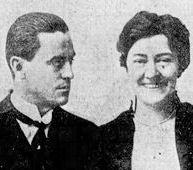
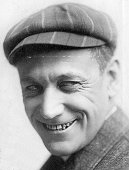
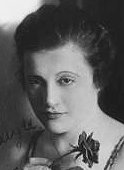 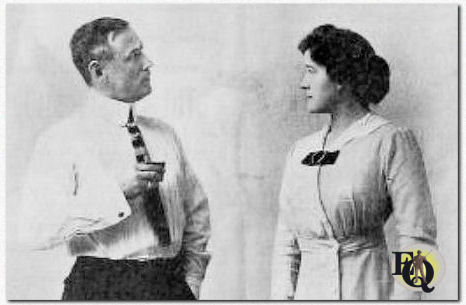 Top left: Charles Grapewin and Anna Chance in a publicity shot for the play Between Showers (Bijou Theatre, Nashville - Apr 1913) Top middle: Charley Grapewin in 1915. Top right: Anna Chance in 1917. Above: Publicity shot for Charley Grapewin and Anna Chance at Orpheum (1915). "Charley Grapewin, the favorite comedian, will appear in the domestic comedy "Poughkeepsie" which is a continuous laugh. He will be supported by Anna Chance, who is not only fair to look upon, but an excellent foil for Mr. Grapewin's humorous acting." |
|
| Typically he toured eight months a year while spending the balance of his year in Long Branch. Grapewin owned a home on Bath Ave. West End, a neighborhood in Long Branch, New Jersey, one of the show places of the fashionable seaside colony. Charley and Anna's home was filled with theatrical memorabilia, and probably a shop (Charley was a talented woodworker building tables with inlaid tops). Grapewin was his own architect and head gardener. The cellar was a most artistic billiard room with a well-stocked buffet and serving table in one corner. The room was illuminated by means of incandescent lights placed in bottles with formerly contained some choice beverage. The floor is a coarse mosaic of shells, stones, coins, and cutlery embedded in the cement floor for a striking effect. The walls were papered with bits of manuscript, most of these having been autographed. It is said that if these walls could have been cut up into blocks and sold they would bring a tidy fortune. | |
|
In 1917 Rex Weber worked on a series of
comedies for the Follies of the Week, Inc, of Chicago. His 2nd
production was The Hawaiidiot, featuring Charley Grapewin.
Weber reportedly established a new record, it is said, completing the
comedy at the Rothacker studio in four and one-half hours. As many people did, in late 1929, he and his wife Anna awakened to discover that their net worth -- once two million dollars -- had dropped to about 200. The exact numbers vary in different accounts of this event. "He had, on paper, one million, two hundred thousand dollars. He was a member of the exclusive Wilshire golf club of Los Angeles. He had a big home, three servants and three motor cars. The next morning, he owed $30,000." |
|

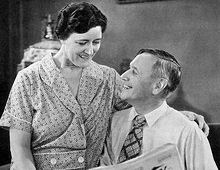
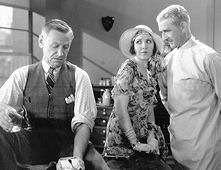 Above left: In 1929, together with his wife Anna Chance, he appeared in 3 shorts by Christie Comedies films: Jed's Vacation, That Red-Headed Hussy (seen here) & Ladies' Choice. Above right: Charley Grapewin with Mary Brian and George Irving in Only Saps Work (Paramount, Dec 6. 1930). |
|
Grapewin kept accounts in which, since his marriage to Anna Chance, he kept track of every penny he received or spent. Charley appeared to be good with money. However, the fact that he overcame this major financial setback was mostly a testament to his versatility and adaptability. It did mean going back to work... and Charley tried his luck in writing (he even dabbled in composing music). Then he moved over into the world of motion pictures when in 1929, together with his wife Anna Chance, he appeared in 3 shorts by Christie Comedies films: Jed's Vacation (Paramount, Apr 13. 1929), Ladies' Choice (Paramount, Sep 14. 1929), and That Red-Headed Hussy (Paramount, Dec 28. 1929), and 1 short by Universal House Cleaning (Universal, Apr 21. 1929). It seems likely that several, if not all, of these short comic films were based on vaudeville sketches. That same year his first feature length movie was The Shannons of Broadway (Universal, Dec 8. 1929).
He
subsequently wrote at least 7 books that proved successful enough to earn him
some income.
The Bronze Bull
(1930) was a novel set in Utah, telling
the story of two brothers, one an honest foreman at the Townsend Glass
Works, the other a slick political animal. In 1933 he
Luckily the arrival of sound in movies meant that actors who could read lines well, were in great demand. Since he had retired to California, Grapewin decided to give Hollywood a try. As the Thirties progressed, Grapewin could be seen in such memorable films as American Madness (Columbia, Aug 4. 1932), Judge Priest (Fox Film, Sep 15. 1934), Alice Adams (RKO Radio Pictures, Aug 15. 1935), The Petrified Forest (Warner Bros., Jan 30. 1936) and Captains Courageous (MGM, May 11. 1937). A 1931 article describes Mr. Grapewin as a "33rd Degree Mason"***. |
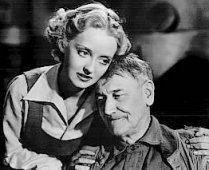
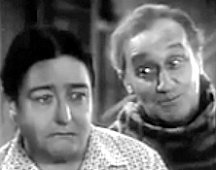 Above left: Hell's House (aka Juvenile Court) (Capitol Film, Feb 10. 1932) with Grapewin (as Uncle Henry) and Bette Davis. Above right: Charley with Helen Westley in Anne of Green Gables (RKO Radio Pictures, Nov 23. 1934) based upon the novel by Lucy Maud Montgomery. |
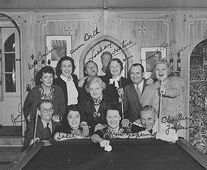 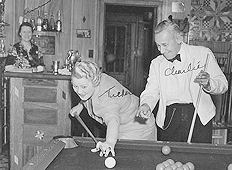 Above: Singer, comedian Sophie Tucker at a party at Charley and Anna Grapewin's home (1937). Right picture shows Sophie with Charley enjoying a game whilst Anna looks on. |
| Best of all his Hollywood breaks came in a friendly poker game one evening in 1936. That night it seemed as if Grapewin just couldn't lose. One of his friends put up as a stake an acre of ground on the famous Fuller Ranch, 50 miles from Hollywood. Charley won the acre and not long after built himself a home there. It had its own private lake and boat landing and with the pond full of bass the actor spent an almost continuous vacation right at home. The groundbreaking was in March 1939, and the large home, christened "Grape-Inn", was completed by fall. Fishing was a popular pastime at their address which was N°1 Grapewin Avenue. Like their cottage in New Jersey, Charley no doubt designed this new commodious house himself. |
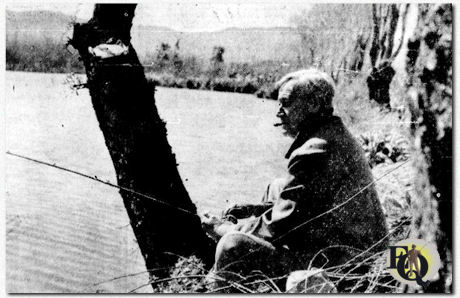 Above: Grapewin fishing in his own pond, on his own estate. As he sits here, the rest of the world leaves him cold. |
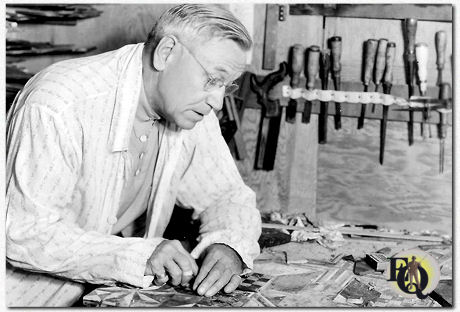 Above: Grapewin's favorite pastime is making decorative Inlays for furniture, with the aid of a kit containing thin strips of wood, a penknife and a bottle of glue. Supplementing in this way the time he can spare for the workshop in his garage, the actor has filled this home and office with unusual inlaid objects. Chairs, tables, a desk for his office, and numerous cigarette boxes are among the pieces he has decorated. One of his most remarkable feats of handiwork is a card table containing 365 inlaid pieces, made in only four days on the "lot." |
| Grapewin boasts that he could do his trapeze tricks as well as when he performed them under the Big Top. He kept his rigging set up in the backyard of his Hollywood home and loves to astound his friends with it. So thoroughly is he in training that when, during the making of The Voice of Bugle Ann (MGM, Feb 15. 1936), he slipped and took a dangerous fall, he landed acrobat-wise and sprang up unhurt, through sheer intuition born of years of practice. |
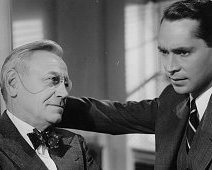
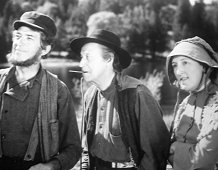 Above left: In 1937 he played Dr. Sam Webster in Between Two Women (MGM, Jul 9. 1937) with Franchot Tone. Above right: Arthur Aylesworth, Charles Grapewin and Brenda Fowler watch the boat bringing Walter Houston, James Stewart and Beulah Bondi to their village in MGM's Of Human Heart (aka Benefits Forgot) (MGM, Feb 5. 1938) directed by Clarence Brown, and produced by John W. Considine Jr. |
| With many of the prestigious roles played by Charley Grapewin we who love The Wizard of Oz (MGM, Aug 10. 1939) will still best remember the lovable Uncle Henry as a part of the total charm of the classic movie. At the time only The Good Earth (MGM, Jan 29. 1937) and Ben Hur (MGM, Dec 30. 1925) cost the movie studio more dollars to produce. M-G-M's The Good Earth was a story written by the West Virginia author Pearl S. Buck and the book won a Nobel Prize in literature and also the prestigious Pulitzer Prize in literature. |
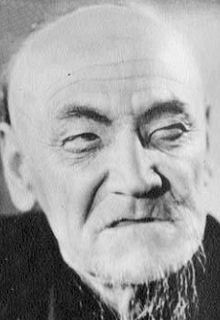
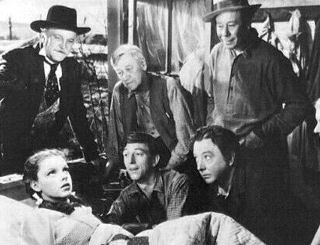 Above left: Almost unrecognizable! Grapewin as the Old father of Wang (Paul Muni) in The Good Earth (MGM, Jan 29. 1937) Above right: Opposite Judy Garland, Charley Grapewin as the lovable Uncle Henry in the classic movie, The Wizard of Oz (MGM, Aug 10. 1939). |
|
It was on his ranch in 1940 that Grapewin and Anna
Chance, celebrated their 45th wedding anniversary, by getting married
again with all the trimming, and for a very logical reason. After they
eloped in 1896 they were married hurriedly and now wanted a wedding they
could remember. Frequently described as grizzled, cantankerous, wheezy, grumpy and a codger in his grandfatherly roles. Success in films came late in his career (he was 60ish). As we remember him best he was of medium height, stocky build with a mop of white hair, square jawed with squinty eyes. He had a slightly raspy voice and a western drawl which served him well in these roles. Between 1940 and 1942 he played Inspector Queen in the unsuccessful series of seven movies based on the Ellery Queen character. |
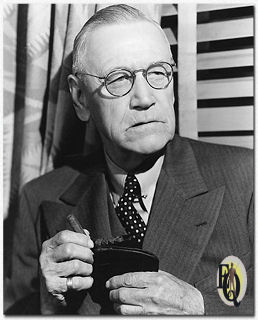 Above left: Charley Grapewin as Inspector Queen in the movie adaptations for Ellery Queen (Columbia, Nov 28. 1940 - July 30. 1942) Above right: From left to right: Grapewin, Ralph Bellamy (Ellery Queen), Margaret Lindsay (Nikki Porter) and Anna May Wong in Ellery Queen and The Penthouse Murder (Columbia, Mar 9. 1941). |
|
One of the next films in which Grapewin played a leading role, as Grandpa Joad, another Pulitzer Prize winning book of John Steinbeck's, The Grapes of Wrath (20th Century-Fox, Jan 24. 1940). He also played Jeeter Lester in the Erskine Caldwell's Tobacco Road
(20th Century Fox, Feb 20. 1941) considered by many as
the highlight of his career. The chance
at Jeeter meant just another job to Charley. When he was called, among
several others, to test for the role, he showed up promptly on the test
stage at the appointed time, 10:30 AM. Came 11 o'clock and director John
Ford had not arrived. Charley grumbled bitterly, said something about
Dad blasted directors, and stalked off the stage in a rage. Before he
could get into his car to drive home, an assistant director, in
desperation, started a conversation with him about fishing. Meanwhile,
Ford arrived and Grapewin was coaxed grudgingly back to the testing
department. |
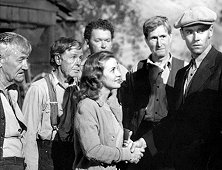
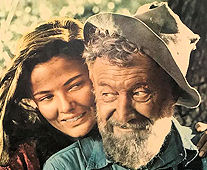 Above left: With Henry Fonda (right) as Grandpa Joad (far left), another Pulitzer Prize winning book of John Steinbeck's, The Grapes of Wrath (20th Century-Fox, Jan 24. 1940). Above right: As Jeeter Lester in Erskine Caldwell's Tobacco Road (20th Century Fox, Feb 20. 1941). |
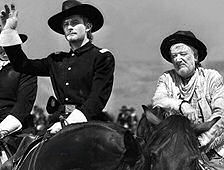 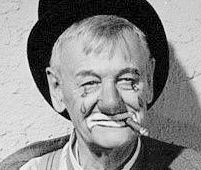 Above left: Here you see Charley assisting Errol Flynn (and Olivia De Havilland) in They Died with Their Boots On (Warner Bros., Nov 20. 1941), a western film directed by Raoul Walsh. Above right: Charley Grapewin in Follow The Boys (Universal, Apr 25. 1944) a picture with Orson Welles and WC Fields in his last role. |
|
In 1942 the novel Meg Randall
was published. Charley's story, was a romance of "fabulous wealth" in which a
woman finds herself after running away to Chicago with a spectacular
night-club manager, an honest gambler Monty Rogers. In September 1943 Anna passed away. Two years later on January 10. 1945 Charley remarried Loretta McGowan, Chicago social figure (one hour before the ceremony she got a divorce from D.W. Becker) in Las Vegas, Nevada. They met several years ago while Charley was touring Illinois on a War Bond drive. Her marriage to Charley would end in divorce on August 26. 1950. Because, the actor said, "She was too damned pretty.” |
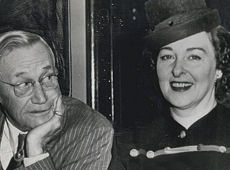 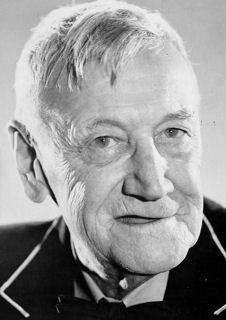 Above left: Charles Grapewin and his bride, the former Mrs. Loretta McGowan Becker of Chicago (Jan 1945). Above right: Charley Grapewin in The Impatient Years (Columbia, Sep 7. 1944). |
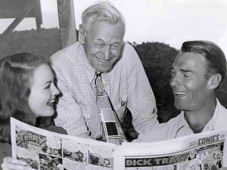
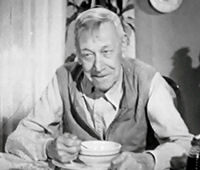 Above left: Charley Grapewin together with Dorothy Hart and Randolph Scott enjoying each others company during filming of Gunfighters (1947) Above right: Grapewin final role as Grandpa Reed in When I Grow Up (Eagle-Lion/United Artists, Apr 20. 1951). |
|
During his life span, with everything else he did, he is credited with having made over 100 films. He last role was as Grandpa Reed in the movie When I Grow Up (Eagle-Lion/United Artists, Apr 20. 1951) where he crossed paths with Harry Morgan (who later would also play Inspector Queen). In a 1951 interview he confided not planing to give up either work or women "until St. Peter casts me in a role.” Grapewin loved living in Corona where he went about his business quietly and very unpretentious. He last appeared in public at the Circle City load races in May 1955. He died on February 2. 1956 in Corona, California of natural causes at age 86. He never had children. Upon the filing of his will it was disclosed that his long time housekeeper was the beneficiary of his Estate. The city where he died named Grapewin Street in his honor. |
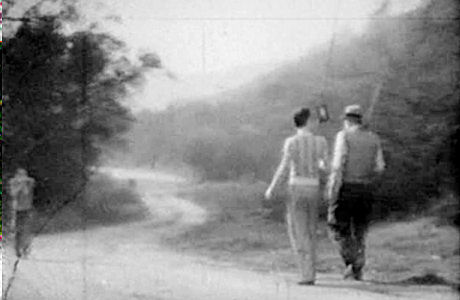 Above: Going fishing with his grandson, the final scene from When I Grow Up (Eagle-Lion/United Artists, Apr 20. 1951). |
|
Notes: * By the mid 1880's Thomas Samwell had teamed up with the American circus manager Adam Forepaugh which toured the U.S. for at least three years. **Above the Limit, according to some, was the alternate title of the other Chimmie film, but a look at the original script reveals that this reworked skit was the base for the screenplay for Chimmie Hicks and the Rum Omelet. *** The Thirty-third Degree is conferred upon those members, not less than 33 years of age, who have been outstanding in their contributions to Freemasonry, the Scottish Rite, or who have shown in their communities the leadership which marks them as men who exemplify in their daily lives. All dates for movies are for the first US release. All dates for TV programs are original first airdates. All dates for (radio) plays are for the time span the actor was involved. Facts in red still need confirmation. |
|
Click on Uncle Sam if you think you can help out...!
|
|
Other references
Additional video & audio
sources
|
|
This actor profile is a part of
Ellery Queen a website on deduction.
The actor above played Inspector Queen in seven of
the
Ellery Queen movies.
Click Uncle Sam if you think you can help
out...! Many of the profiles on this site have been compiled after very careful research of various sources. Please quote and cite ethically! |
|
Page first published on January 1. 2010 Version x2.1 - Latest update April 22. 2025 |
 b a c k
t o L i s t o f S u s p
e c t s
b a c k
t o L i s t o f S u s p
e c t s
|
|
| Introduction | Floor Plan | Q.B.I. |
List of Suspects | Whodunit? | Q.E.D. | Kill as directed | New | Copyright Copyright © MCMXCIX-MMXXV Ellery Queen, a website on deduction. All rights reserved. |